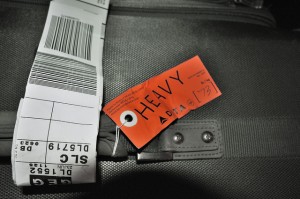What’s in Your Bag? Back Pain Edition

Overweight cargo can cause more trouble than just pain.
The soreness we experience in our shoulders, upper and lower back, and hips which can be partially attributed to our overweight baggage is no small matter. In fact, most chiropractors would agree that the pain is merely a symptom of a larger problem such as misalignment, nerve compression, or excessive strain on the muscles and spine. Ideally, a person should carry no more than 10% of his body weight at a given time and most people are heaving two to four times that. In short, a majority of Americans who are over-carrying are not only experiencing the accompanied discomfort but are probably injuring themselves as well.
There are many ways to effectively reduce and reverse injury.
One of the potentially easiest ways to reduce the weight of one’s bag and return carriage to a healthy weight is to simply take less along. It is recommended to take frequent stock of what is actually being carried and eliminate all but the essentials. Tips to make downsizing easier include:
Choose a smaller bag. The science is simple. If the bag is smaller, less will fit. The smaller bag will also inspire more frequent rearranging of the articles inside which may cause more frequent emptying of heavy spare change or that water bottle from a week ago.
Divide and conquer. For people who have items for their children, work materials, daily stuff, and gear for the gym stuffed into one glorious mega-bag, there may not be a way to cut cargo. An alternate option is to split up the stuff into categories and only carry what is being used at present, leaving the rest in the car or office.
Opt for wheels. Whether it was feasible to cut 10 pounds out of your bulging bag or not, a wheeled bag offers an alternative that redistributes the heft and keeps the responsibility off of your spine. Wheeled bags, once popular for travelers above anyone else, are now becoming more popular to tote around laptops and business files, and even school bags.
It’s not what you carry, but how you carry it
The weight of cargo is really only half of the battle when it comes to protecting spinal health and eradicating back pain. Even individuals who carry only the requisite 10% of their body weight – and especially those who carry more – should consider how the weight is being distributed and managed. The key is to choose the proper bag to suit lifestyle demands and carry it properly. Consider symmetry by opting for a backpack or switching sides with a one-strap bag and be sure to fit the bag as close to your body and high up on your torso as possible. Thick straps will also add comfort and prevent muscle tug.
The modern age is one of stuff-coveting that has become the nemesis of spine health enthusiasts and Freehold chiropractors. Reduce your load and carry it mindfully to preserve alignment and avoid back pain.